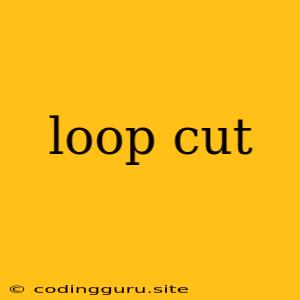Loop Cut: A Powerful Tool for Mesh Manipulation in Blender
Loop cuts are a fundamental tool in Blender for sculpting and manipulating your 3D meshes. They provide a quick and efficient way to add edges and vertices to your model, allowing you to refine its shape and add intricate details.
What is a Loop Cut?
A loop cut is a technique used to add new edges along a continuous loop of existing edges in a mesh. This loop can be horizontal, vertical, or any other direction, and it will create new vertices and edges to connect the existing ones.
Why Use Loop Cuts?
Here are some key reasons why you should master loop cuts in Blender:
- Adding detail: You can use loop cuts to create more detail in your model by adding new edges to existing faces. This is useful for creating creases, wrinkles, and other surface variations.
- Refining geometry: If you need to adjust the shape of your mesh in a specific area, loop cuts provide a quick and controlled way to add or remove geometry.
- Creating smooth curves: Loop cuts can help you create smooth curves in your mesh, especially for areas like limbs or rounded objects.
- Evenly distributing vertices: Loop cuts help distribute vertices evenly, which is important for maintaining smooth surfaces and avoiding unwanted distortions.
How to Create a Loop Cut in Blender
- Select the edge loop: Select the edge loop you want to cut by holding Alt and clicking on an edge of the loop.
- Press "Ctrl + R": This activates the loop cut tool.
- Move your mouse: Move your mouse across the mesh to indicate the direction of the loop cut.
- Click: Click to create the loop cut. You can move your mouse left or right to control the number of cuts created.
- Use the "Scroll Wheel": You can use the scroll wheel of your mouse to increase or decrease the number of loop cuts made.
Loop Cut Variations
- Loop Cut and Slide: You can slide the new loop of vertices by holding Ctrl after creating a loop cut. This allows you to reposition the new edges more precisely.
- Loop Cut and Slide with Transform Shortcuts: Use the following shortcut keys to quickly reposition your loop cut:
- G: Move the loop cut
- S: Scale the loop cut
- R: Rotate the loop cut
- Loop Cut with Pivot Point: Use the Pivot Point option to control where the loop cut is made from. This is useful for creating cuts that follow a specific path or curve.
Practical Examples
Here are a few practical examples of how you can use loop cuts in your workflow:
- Modeling a character's arm: You can use loop cuts to create the shape of the arm, then add more cuts to define muscles and wrinkles.
- Creating a smooth curved surface: You can use loop cuts to create a smooth curve in a mesh, such as the top of a helmet or the curve of a vehicle's hood.
- Creating a complex organic shape: By strategically placing loop cuts and using the slide function, you can create complex organic shapes like a tree trunk or a character's face.
Tips and Tricks
- Keep your mesh clean: Before you start using loop cuts, make sure your mesh is clean and free of any unnecessary vertices or edges.
- Practice in a new file: Experiment with loop cuts in a separate file before applying them to your final model. This way, you can get familiar with the tool without risking any damage to your work.
- Use the "Snap" function: The "Snap" function can be incredibly helpful when using loop cuts. You can snap the loop cut to existing vertices or edges for more precise results.
Conclusion
Loop cuts are a versatile and powerful tool for mesh manipulation in Blender. Mastering this technique will greatly enhance your workflow and allow you to create more detailed, refined models. Remember to practice regularly, experiment with different variations, and take advantage of the tips and tricks mentioned above to maximize your results.
